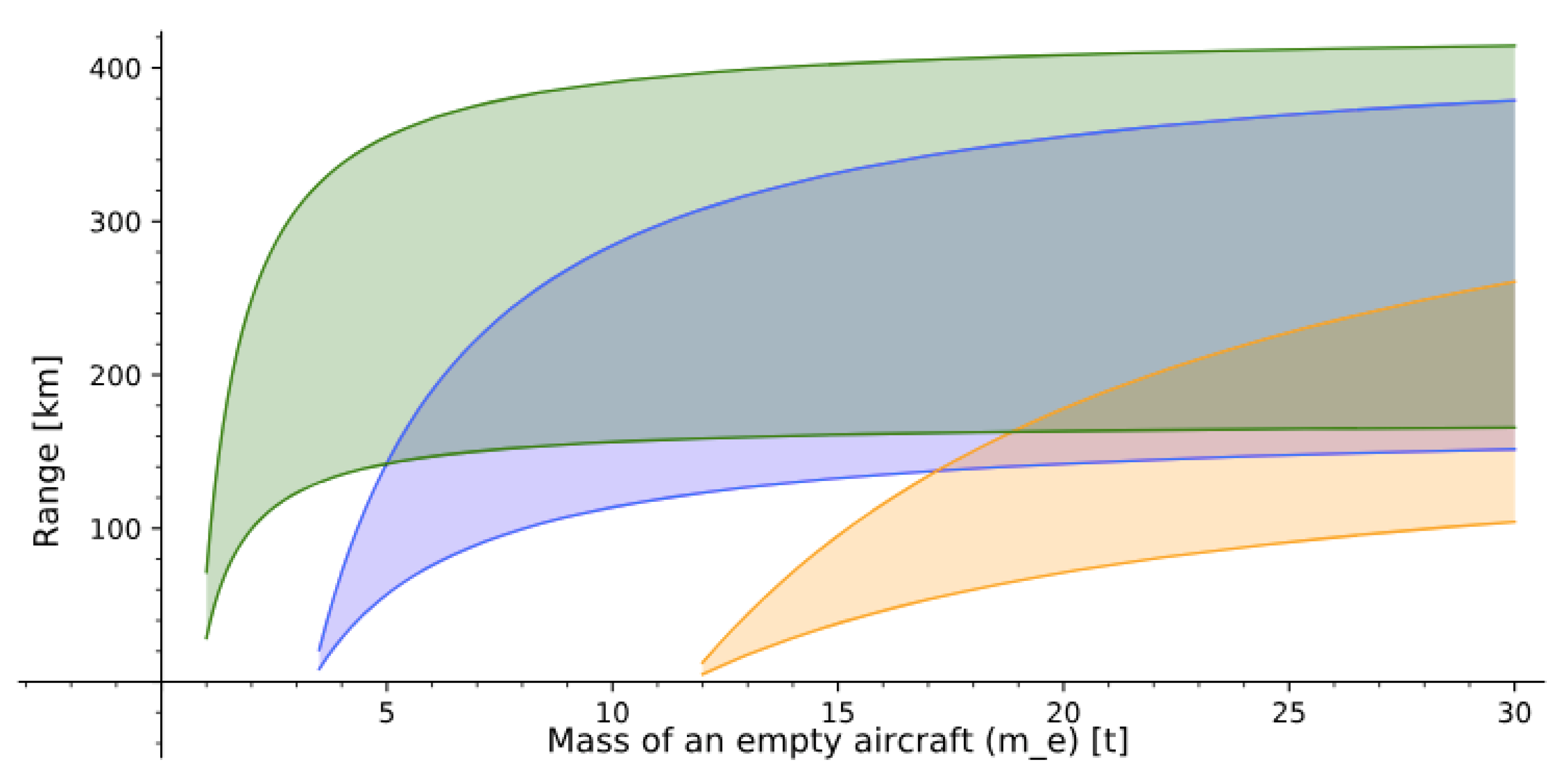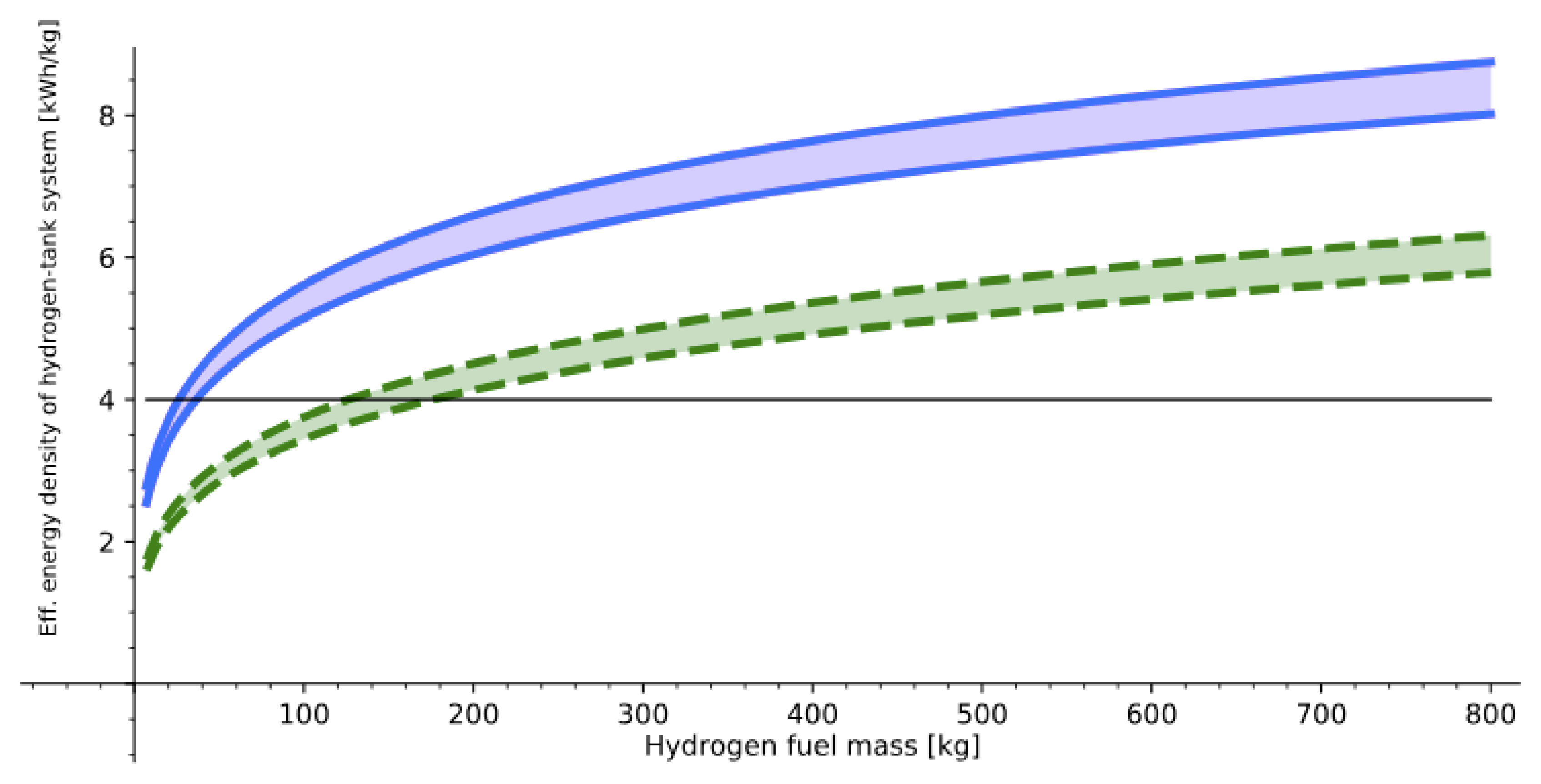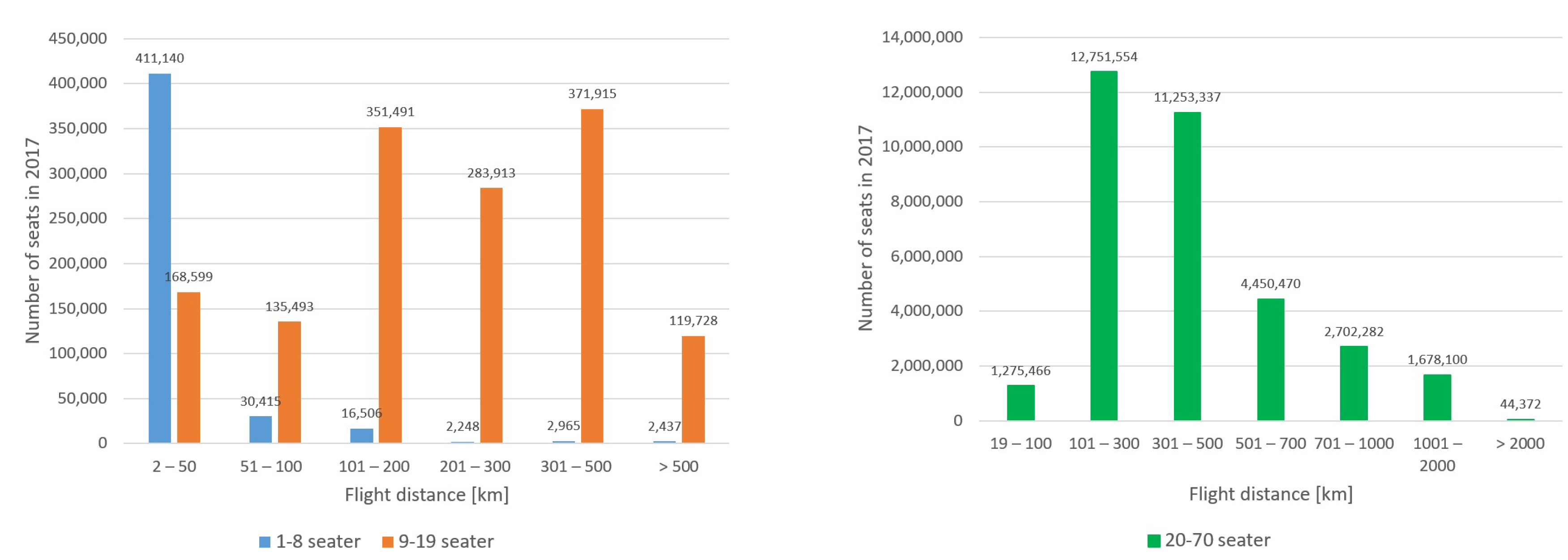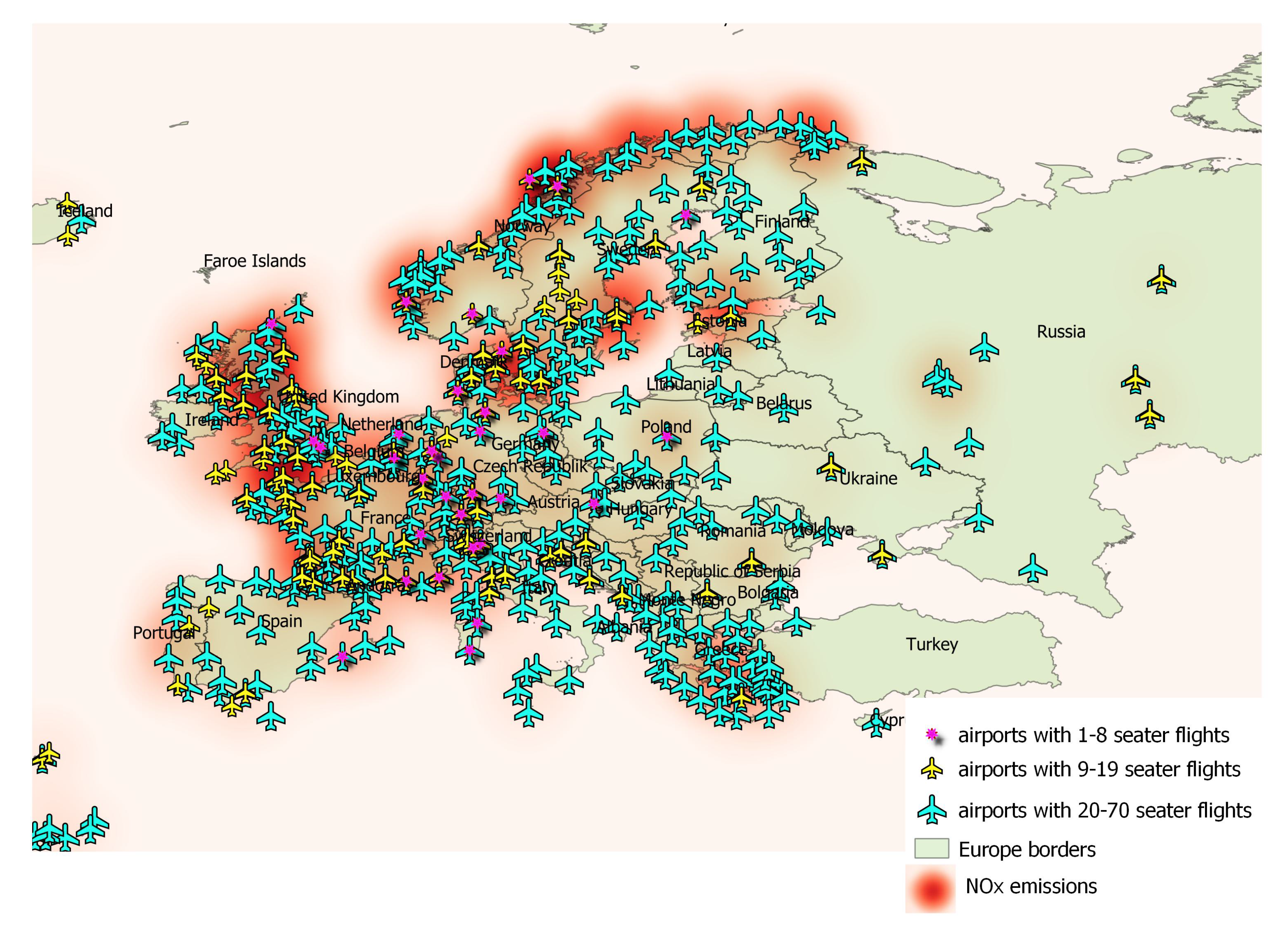Market and Technological Perspectives for the New Generation of Regional Passenger Aircraft
Abstract
1. Introduction
2. Technological Characteristics of Regional Electric and Hybrid Aircraft
2.1. An All-Electric Aircraft
2.2. A Hybrid Aircraft
2.3. Fuel-Cell Aircraft
3. Estimation of Potential Number of Aircraft That Could Be Replaced with All-Electric or Hybrid Aircraft in Near Future
4. Emission Analysis of Regional Air Transport in EU
5. Conclusions
Author Contributions
Funding
Acknowledgments
Conflicts of Interest
Abbreviations
| EU | European Union |
| U.K. | United Kingdom |
| ACRE | Advisory Council for Aeronautical Research |
| EBAA | European Business Aviation Association |
| DLR | Deutsches Zentrum für Luft und Raumfahrt (German Aerospace Center) |
| ICAO | International Civil Aviation Organization |
| OAG | Official Aviation Guide |
| RPK | Revenue Passenger Kilometres |
| L/D | lift over drag ratio |
| r. o. c. | rate of climb |
| LiFePO | Lithium iron phosphate battery |
| LTO | landing and take-off cycle |
| nitrogen oxides | |
| CO | carbon monoxide |
| HC | hydrocarbons |
| carbon dioxide | |
| nitrous oxide | |
| water vapour | |
| sulphur oxides | |
| t | tonne (1000 kg) |
References
- European_Commission. Annual Analyses of the EU Air Transport Market; Technical Report; Mott MacDonald: Croydon, UK, 2017. [Google Scholar]
- FlightGlobal. Flight Fleet Forecast 2018–2037; Technical Report. Available online: https://www.flightglobal.com/products/flight-fleet-forecast/ (accessed on 16 May 2019).
- European_Commission. Airport Policy in the European Union—Addressing Capacity And Quality to Promote Grow, Connectivity and Sustainable Mobility; Technical Report COM(2001) 823 Final; European Commission: Brussels, Belgium, 2011. [Google Scholar]
- TASK_FORCE. European Observatory on Airport Capacity and Quality; Technical Report. Available online: https://ec.europa.eu/transport/sites/transport/files/modes/air/airports/doc/tf3_final_report.pdf (accessed on 16 May 2019).
- Argüelles, P.; Bischoff, M.; Busquin, P.; Droste, B.A.C.; Evans, R.; Kröll, W.; Lagardère, J.L.; Lina, A.; Lumsden, J.; Ranque, D.; et al. European Aeronautics: A Vision for 2020, Meeting Society’s Needs and Winning Global Leadership; Technical Report. Available online: https://www.acare4europe.org/sites/acare4europe.org/files/document/Vision%202020_0.pdf (accessed on 16 May 2019).
- Buchmann, I. Batteries in a Portable World, 4th ed.; Cadex Electronics Inc.: Richmond, BC, Canada, 2016; p. 360. [Google Scholar]
- Anderson, J.D. Aircraft Performance and Design, 5th ed.; Tata McGraw-Hill: New Delhi, India, 1999. [Google Scholar]
- Schäfer, A.W.; Barrett, S.R.H.; Doyme, K.; Dray, L.M.; Gnadt, A.R.; Self, R.; O’Sullivan, A.; Synodinos, A.P.; Torija, A.J. Technological, economic and environmental prospects of all-electric aircraft. Nat. Energy 2019, 4, 160–166. [Google Scholar] [CrossRef]
- Gohardani, A.S.; Doulgeris, G.; Singh, R. Challenges of future aircraft propulsion: A review of distributed propulsion technology and its potential application for the all electric commercial aircraft. Prog. Aerosp. Sci. 2011, 47, 369–391. [Google Scholar] [CrossRef]
- Baharozu, E.; Soykan, G.; Ozerdem, M.B. Future aircraft concept in terms of energy efficiency and environmental factors. Energy 2017, 140, 1368–1377. [Google Scholar] [CrossRef]
- Adolf, J.; Balzer, C.; Louis, J.; Schabla, U. Shell Hydrogen Study: Energy of the Future; Technical Report; Shell Deuchland Oil GmbH: Hamburg, Germany, 2017. [Google Scholar]
- Sørensen, B.; Spazzafumo, G. Hydrogen and Fuel Cells, Emerging Technologies and Applications, 3rd ed.; Elsevier Ltd.: London, UK, 2018; p. 501. [Google Scholar]
- HY4—Delivering the Future. Available online: http://hy4.org/ (accessed on 16 May 2019).
- Godula-Jopek, A.; Westenberger, A. Hydrogen-Fueled Aeroplanes. Compend. Hydrogen Energy 2016, 4, 67–85. [Google Scholar] [CrossRef]
- Keim, M.; Kallo, J.; Friedrich, K.A.; Werner, C.; Saballus, M.; Gores, F. Multifunctional fuel cell system in an aircraft environment: An investigation focusing on fuel tank inerting and water generation. Aerosp. Sci. Technol. 2013, 29, 330–338. [Google Scholar] [CrossRef]
- Khandelwal, B.; Karakurt, A.; Sekaran, P.R.; Sethi, V.; Singh, R. Hydrogen powered aircraft: The future of air transport. Prog. Aerosp. Sci. 2013, 60, 45–59. [Google Scholar] [CrossRef]
- Romeo, G.; Borello, F.; Correa, G.; Cestino, E. ENFICA-FC: Design of transport aircraft powered by fuel cell & flight test of zero emission 2-seater aircraft powered by fuel cells fueled by hydrogen. Int. J. Hydrogen Energy 2013, 38, 469–479. [Google Scholar] [CrossRef]
- Schmidtchen, U.; Behrend, E.; Pohl, H.W.; Rostek, N. Hydrogen Aircraft and Airport Safety. Renew. Sustain. Energy Rev. 1997, 1, 239–269. [Google Scholar] [CrossRef]
- Gong, A.; Verstraete, D. Fuel cell propulsion in small fixed-wing unmanned aerial vehicles: Current status and research needs. Int. J. Hydrogen Energy 2017, 42, 21311–21333. [Google Scholar] [CrossRef]
- Sehra, A.K.; Whitlow, W. Propulsion and power for 21st century aviation. Prog. Aerosp. Sci. 2004, 40, 199–235. [Google Scholar] [CrossRef]
- Verstraete, D. Long range transport aircraft using hydrogen fuel. Int. J. Hydrogen Energy 2013, 38, 14824–14831. [Google Scholar] [CrossRef]
- Verstraete, D. On the energy efficiency of hydrogen-fuelled transport aircraft. Int. J. Hydrogen Energy 2015, 40, 7388–7394. [Google Scholar] [CrossRef]
- Pascarella, C.; Marinaro, G.; Senatore, A.; Di Lorenzo, G.; Frosina, E.; Caputo, C. Modelling of a Hybrid-Electric Light Aircraft. Energy Procedia 2017, 126, 1155–1162. [Google Scholar] [CrossRef]
- Pornet, C.; Isikveren, A.T. Conceptual design of hybrid-electric transport aircraft. Prog. Aerosp. Sci. 2015, 79, 114–135. [Google Scholar] [CrossRef]
- Pipistrel—Pipistrel Official Web Page. Available online: https://www.pipistrel-aircraft.com/ (accessed on 16 May 2019).
- Voskuijl, M.; van Bogaert, J.; Rao, A.G. Analysis and design of hybrid electric regional turboprop aircraft. CEAS Aeronaut. J. 2018, 9, 15–25. [Google Scholar] [CrossRef]
- Technical Data | Panthera. Available online: https://www.panthera-aircraft.com/technical-data (accessed on 16 May 2019).
- Martinez-Val, R.; Perez, E.; Palacin, J. Historical Perspective of Air Transport Productivity and Efficiency. In 43rd AIAA Aerospace Sciences Meeting and Exhibit; American Institute of Aeronautics and Astronautics: Reston, VA, USA, 2005. [Google Scholar] [CrossRef]
- Righetti, A.P.; Falger, A.C.; Flade, S.D.; Perkan, I.P. Performance and Energy Efficiency Trade of Study; Technical Report. Available online: https://mahepa.eu/wp-content/uploads/2017/12/D1.1-Concept-of-Modular-Architecture-fro-Hybrid-Electric-Propulsion-of-Aircraft.pdf (accessed on 16 May 2019).
- Dababneh, O.; Kipouros, T. A review of aircraft wing mass estimation methods. Aerosp. Sci. Technol. 2018, 72, 256–266. [Google Scholar] [CrossRef]
- Atmaja, T.D. Energy storage system using battery and ultracapacitor on mobile charging station for electric vehicle. Energy Procedia 2015, 68, 429–437. [Google Scholar] [CrossRef]
- Sirosh, N. Hydrogen Composite Tank Program. In Proceedings of the 2002 U.S. DOE Hydrogen Program Review, San Ramon, CA, USA, 9–11 May 2000; pp. 1–7. [Google Scholar]
- OAG_Organization. OAG Schedules Analyser. Available online: https://www.oag.com/schedules-analyser (accessed on 16 May 2019).
- EBAA. European Business Aviation—Economic Value and Business Benefits; European Business Aviation Association: Brussels, Belgium, 2018. [Google Scholar]
- PRIVATEFLY. Private Jet Charter Trends. Available online: https://www.privatefly.com/privatejet-services/privatefly-private-jet-charter-trends-report.html (accessed on 16 May 2019).
- Brasseur, G.P.; Gupta, M.; Anderson, B.E.; Balasubramanian, S.; Barrett, S.; Duda, D.; Fleming, G.; Forster, P.M.; Fuglestvedt, J.; Gettelman, A.; et al. Impact of Aviation on Climate: FAA’s Aviation Climate Change Research Initiative (ACCRI) Phase II. Bull. Am. Meteorol. Soc. 2016, 97, 561–583. [Google Scholar] [CrossRef]
- Filippone, A.; Bojdo, N. Statistical model for gas turbine engines exhaust emissions. Transp. Res. Part D Transp. Environ. 2018, 59, 451–463. [Google Scholar] [CrossRef]
- EASA. Commercial Air Transport Aeroplane Operations at Night or in IMC Using Single-Engined Turbine Aeroplane. Available online: https://www.easa.europa.eu/sites/default/files/dfu/NPA%202014-18.pdf (accessed on 16 May 2019).
- EASA. ICAO Aircraft Engine Emissions Databank. Available online: https://www.easa.europa.eu/easa-and-you/environment/icao-aircraft-engine-emissions-databank (accessed on 16 May 2019).







| Aircraft Size | No. of | Weighted Average (g) | for Year 2017 (Tonnes) | ||||
|---|---|---|---|---|---|---|---|
| (Seats) | Flights | HC | CO | NOx | HC | CO | NOx |
| 1–8 | 84,326 | na | na | na | na | na | na |
| 9–19 | 79,887 | 115.4 | 2504.2 | 1364.0 | 9.2 | 200.1 | 109.0 |
| 20–70 | 676,577 | 93.3 | 2672.8 | 1589.2 | 63.2 | 1808.3 | 1075.2 |
| ∑ | 72.4 | 2008.3 | 1184.2 | ||||
© 2019 by the authors. Licensee MDPI, Basel, Switzerland. This article is an open access article distributed under the terms and conditions of the Creative Commons Attribution (CC BY) license (http://creativecommons.org/licenses/by/4.0/).
Share and Cite
Prapotnik Brdnik, A.; Kamnik, R.; Marksel, M.; Božičnik, S. Market and Technological Perspectives for the New Generation of Regional Passenger Aircraft. Energies 2019, 12, 1864. https://doi.org/10.3390/en12101864
Prapotnik Brdnik A, Kamnik R, Marksel M, Božičnik S. Market and Technological Perspectives for the New Generation of Regional Passenger Aircraft. Energies. 2019; 12(10):1864. https://doi.org/10.3390/en12101864
Chicago/Turabian StylePrapotnik Brdnik, Anita, Rok Kamnik, Maršenka Marksel, and Stanislav Božičnik. 2019. "Market and Technological Perspectives for the New Generation of Regional Passenger Aircraft" Energies 12, no. 10: 1864. https://doi.org/10.3390/en12101864
APA StylePrapotnik Brdnik, A., Kamnik, R., Marksel, M., & Božičnik, S. (2019). Market and Technological Perspectives for the New Generation of Regional Passenger Aircraft. Energies, 12(10), 1864. https://doi.org/10.3390/en12101864





